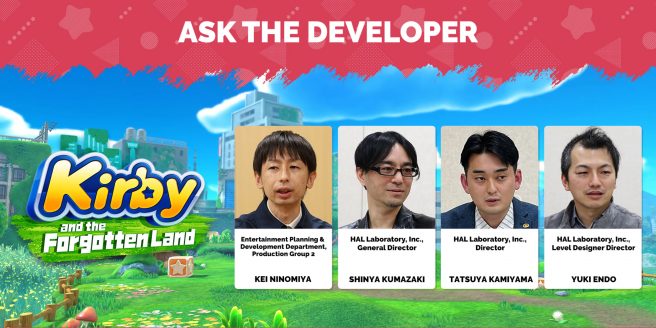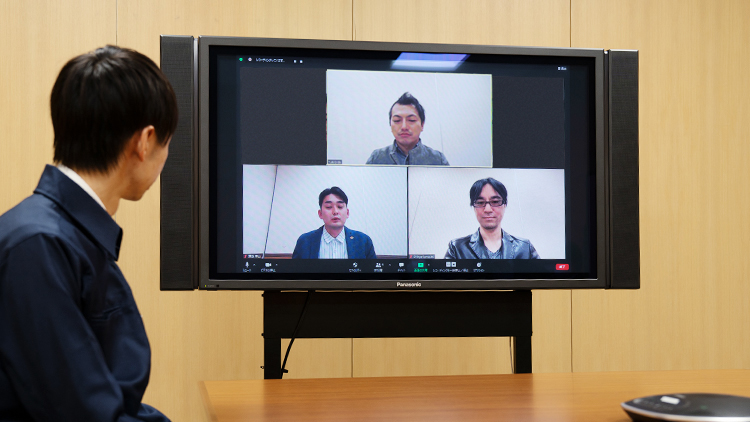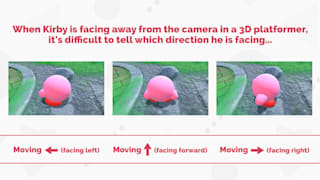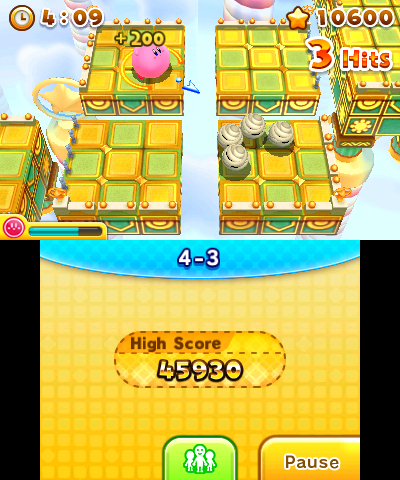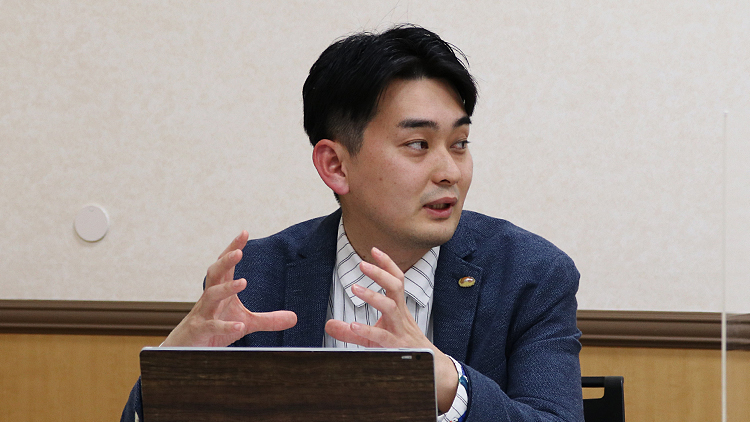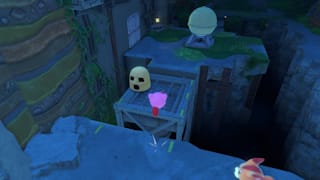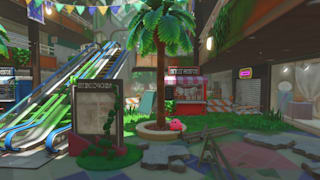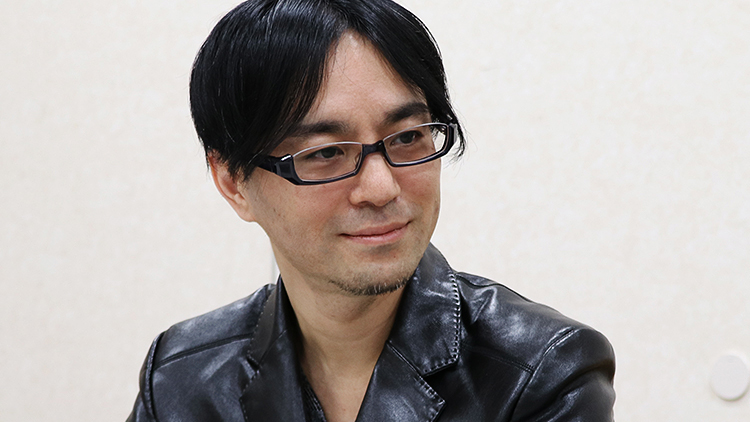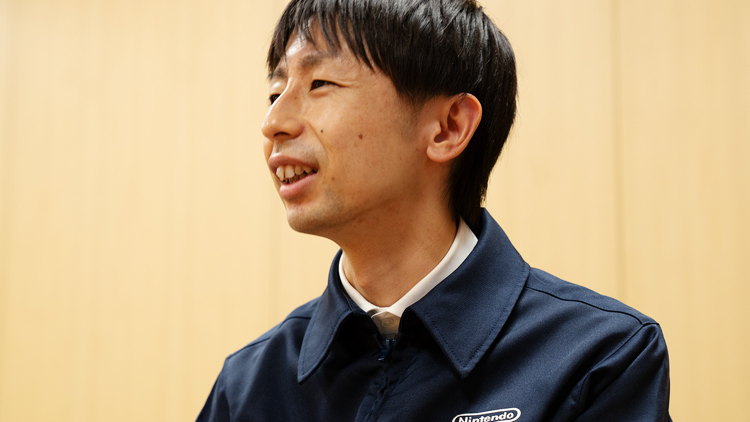Nintendo shares Kirby and the Forgotten Land developer interview
Nintendo has just shared a new Ask the Developer article for Kirby and the Forgotten Land. Kei Ninomya, the game’s associate producer, Shinya Kumazaki, the general supervisor and writer, Tatsuya Kamiyama, the director and Yuki Endo, the level design director, have all participated in the discussion to provide some more insight on the development of the game.
There’s a lot of neat insight offered into techniques used to make Kirby’s transition into 3D feel as smooth as possible, as well as discussion over the tone and setting of the game.
Have a look at the full developer interview below:
In this volume of Ask the Developer, an interview series in which Nintendo developers convey in their own words Nintendo’s thoughts about creating products and the specific points they are particular about, we’re talking to developers behind Kirby and the Forgotten Land for Nintendo Switch, launching on March 25th.
- Chapter 1: Why aren’t the stages more densely populated?
- Chapter 2: I can’t believe this is the first mainline, 3D Kirby title!
- Chapter 3: Just an extra bit of “flavour”
- Chapter 4: Even more wild and free
Chapter 1: Why aren’t the stages more densely populated?
Let’s start with a quick round of introductions, if you don’t mind.
Kei Ninomiya (referred to as Ninomiya from this point on):
Hello! I’m Kei Ninomiya from Nintendo. As the associate producer of this title, I communicated with everyone at HAL Laboratory (1) as we proceeded with development. I’ve been involved in the Kirby series since Kirby: Planet Robobot.(1) HAL Laboratory, Inc., a software development company that creates Kirby games and has been involved in the Super Smash Bros. series and other games.
Shinya Kumazaki (referred to as Kumazaki from this point on):
Hi, I’m Shinya Kumazaki from HAL Laboratory. I’ve been involved in the Kirby series for around 20 years. I’ve served as the general director of the series since Kirby: Planet Robobot. For this title, I supervised the overall project, including character designs, in-game audio and more. I was also in charge of the narrative direction and writing game text, among other tasks.Tatsuya Kamiyama (referred to as Kamiyama from this point on):
Hi! I’m Tatsuya Kamiyama from HAL Laboratory. I’ve been involved with this series since Kirby’s Adventure Wii, but this was my first title I worked on as a director. I was in charge of the overall structure of the game, checking character behaviour, drafting the story, working on cutscenes (2), and more.(2) Cutscene, an in-game movie that expresses the story, such as conversations between characters or dialogue with an enemy.
Yuki Endo (referred to as Endo from this point on):
Hello! I’m Yuki Endo, also from HAL Laboratory. I’ve been involved with the series since Kirby’s Adventure Wii, as well. I was the level design director for this recent title, which means I created and supervised the specs for things like enemies and individual stage mechanics, then arranged them to create each stage.Thank you. And thanks for finding the time to join us for this remote interview! As representatives from both companies, HAL Laboratory and Nintendo, we’d love to hear your thoughts on this title, including development stories and examples of your trial-and-error process. Mr Ninomiya, would you be willing to kick us off with a brief introduction to Kirby and the Forgotten Land?
Ninomiya:
I wouldn’t mind at all. Kirby and the Forgotten Land is the latest title in the main Kirby series, but it’s also Kirby’s first fully 3D platformer. The game is set in a new location, a world filled with the ruins of a past civilisation. Players control Kirby as they freely explore and complete each stage. Like in earlier games, Kirby can still fly, inhale enemies, and copy their abilities, but we’ve added some new actions as well, like evolving each Copy Ability and using Mouthful Mode. So, a feature of the game is that there are a variety of actions with which to play.You mentioned that this is the first mainline instalment in this series to focus on 3D platforming. What inspired you to take Kirby in this new direction?
Kumazaki:
Looking back on the history of the Kirby series, there was a period of time where certain game concepts simply refused to come together (https://www.nintendo.co.uk/Iwata-Asks/Iwata-Asks-Kirby-s-Adventure-Wii/Iwata-Asks-Kirby-s-Adventure-Wii/1-The-Three-Lost-Kirby-Games/1-The-Three-Lost-Kirby-Games-230159.html). As a result, we weren’t able to release a mainline Kirby game on a home console for a little over a decade. We kept hitting walls we couldn’t climb over.From that point on, our game prototypes shifted to a “trial-and-error” approach. We played with unconventional gameplay angles through comparatively smaller games in the series (3) as a way to further explore the concept of a Kirby-based 3D platformer.
We still had plenty of unique challenges to overcome, though. Some in HAL Laboratory even felt that only 2D games should count as “real” Kirby games, so to speak, so we weren’t able to reach a point where we could deliver a complete 3D-platforming mainline Kirby title.
(3) Titles such as Kirby Air Ride (released in February 2004 on Nintendo GameCube), Kirby’s Blowout Blast (released in July 2017 on Nintendo 3DS), Kirby Battle Royale (released in November 2017 on Nintendo 3DS), etc.
Ninomiya:
I watched that process unfold from the Nintendo side of things. As far as I was concerned, Kirby was already a perfect candidate for 3D platforming since the series features actions like jumping and hovering.I had worked with HAL Laboratory on several titles by that point, so I knew they were technically skilled and great at finding new ways to draw out Kirby’s inherent appeal. It felt like I was just patiently counting the days until they eventually reached out and said, “We’re ready for 3D!”.
Kamiyama:
Personally, I thought that a Kirby game where you could freely explore a 3D space would be a lot of fun. However, when it came to directing the game, realistically there were a lot of issues that needed to be solved. For example, we found that even the basic actions of inhaling, spitting out, or jumping didn’t work as expected when simply put into 3D as is… So, we looked at Kirby’s behaviour in past games, and spent a lot of time thinking about what to do to make a proper mainline Kirby game that can be enjoyed in 3D.Kumazaki:
The project proposal I received from Mr Kamiyama for this game was so passionate; it was like nothing I’d seen before. It didn’t focus on the aspects we usually focus on, like new game details or a new setting for the adventure. Instead, it offered guaranteed solutions to each of those tricky 3D-platforming issues that had held the concept back for so long, including specific control scheme plans to ensure players would have fun. With a proposal that solid, I knew we’d be OK, so work on the project officially began shortly after that.I see! You mentioned that it wasn’t easy to transition Kirby’s standard gameplay into 3D platforming. Could you give a clearer picture of the challenges you faced?
Kamiyama:
Of course. The first challenge – and we knew this from the start – was that Kirby’s character design was not a perfect fit for full 3D gameplay. Kirby’s silhouette is perfectly round. When you’re controlling him from behind, it can be hard to tell which direction he’s facing at a glance.I suppose that is a Kirby-specific issue! (Laughs)
What difficulties did you face in terms of the game’s development?
Kamiyama:
Well, our standard development approach had to be reconsidered from the ground up. Since we were moving into 3D play environments, we had to enhance our shadows and lighting, place many more objects throughout each stage, and so on. There’s more to see in each area, which meant there was also more work for us to do.To help our team make the best use of their time, we developed a system that could give certain areas an automatic “terrain-modelling” (4) pass. That boosted our efficiency and saved us time. Since the stages were modelled quickly, it allowed us more time to think of ways to play in that stage, and therefore we were able to experiment more quickly and more smoothly with gameplay on maps.
(4) “Modelling” means to create three-dimensional objects and environments that appear in the game.
I feel like 3D platformers are a bit harder to play compared to 2D platformers. Was there any change in your approach to this game’s difficulty?
Kumazaki:
The concepts of games being enjoyable for anyone, as well as being highly accessible yet still offering a lot of depth, are aspects that we have treasured in the Kirby series. When I began planning this game’s difficulty level, I pictured a 3D platformer easy enough that even a three-year-old child could play…However, as we structured our new 3D platformer around the same sensibilities as our classic 2D games, I noticed that the thrills and sense of adventure were not as prominent.
So the sense of adventure wasn’t as prominent when you shifted from 2D to 3D?
Endo:
Players have a lot more space to move in a 3D game, so they can easily evade most enemy attacks by simply stepping out of the way. If it’s easier for players to evade enemy attacks, the difficulty will drop sharply…unless you surround Kirby with enemies and have all of them attack simultaneously.Kamiyama:
In 2D platformers, you only have two ways to get past an enemy: either jump over them or attack head-on. But in 3D platformers, you often have a variety of ways to run right by an enemy without having to fight at all.What were your thoughts on this issue, Mr Ninomiya?
Ninomiya:
On the Nintendo side, we play through completed sections of the game as development progresses, then provide our feedback. We kept suggesting that HAL Laboratory increase the number and placement of enemies, but new stages would still arrive with noticeable gaps in terms of enemy encounters. I made a point to ask them directly, “Why aren’t the stages more densely populated?”Their response was that it wouldn’t be fair to poor Kirby to surround him with an overwhelming number of opponents!
“Poor Kirby”?
Kumazaki:
They weren’t joking! Everyone on our development staff really loves Kirby, so no one wanted to torment him with an unfair situation.We also thought about people who aren’t skilled at 3D platformers and wanted to provide them with quieter areas where they could play and explore peacefully. So, no matter how many enemies we placed on the map for players to defeat, we couldn’t fill in all the gaps.
Kamiyama:
Our staff kept younger players in mind, as well as players who aren’t great at platformers. There’s Kirby’s default state where he doesn’t have any abilities at all, then states where he gains short-range or long-range attacks. We were concerned about poor Kirby potentially being swarmed and attacked by enemies without any abilities to fight back or defend himself. That’s why it was difficult to adjust those areas.Ninomiya:
The 3D gameplay didn’t have as much “bite” at first, but I never would have guessed that could be sourced back to the development team wanting to protect poor Kirby!HAL Laboratory makes their design choices based on their own sensibilities and past experiences. That being said, we continued to provide feedback from the Nintendo end regarding potential consumer reactions. Over time, we bridged the gap with one another.
Chapter 2: I can’t believe this is the first mainline, 3D Kirby title!
You mentioned that, as part of this transition to 3D action, you had to increase the density of elements in each stage, which meant the enemy difficulty needed to be adjusted to match. Did you also have to make adjustments to the way Kirby attacks?
Ninomiya:
We made adjustments so that the stresses players might feel as they attack enemies would be reduced.Kamiyama:
I know we mentioned that it can be hard to tell which way Kirby is facing in 3D, but for Kirby’s Blowout Blast (5), a small-scale 3D action game where players could inhale enemies and spit them back out, there was an arrow to show where you were attacking.In this Kirby game, however, always pointing forward with an arrow made it feel like you were controlling the arrow, not Kirby. We had to think of a way to easily control and aim Kirby without the arrow’s help.
Now, if it looks like an attack “should” hit on-screen, we make sure it does connect – even if it was going to narrowly miss.
The game accounts for the player’s perspective by tracking the positions of Kirby and the camera. It then maps out a range in which attacks may appear to land. If an attack is within that range, the attack will hit. By doing so, even people who are not so good at 3D action games can attack enemies without any stress.
(5) Kirby’s Blowout Blast, a side-scrolling 3D action game based on Kirby: Planet Robobot, released in July 2017 for Nintendo 3DS. You would move around a 3D space while inhaling and spitting out enemies to get a high score.
So you adjusted it to make sure that the attacks players think are a “hit” will become a “hit” to make players feel satisfied?
Kamiyama:
Talking about the adjustments, the actions associated with the Copy Ability that Kirby uses also needed to be adjusted so it would be easier for players to enjoy in 3D. Even long-established Copy Abilities like Sword or Fire were redesigned from scratch to help players feel satisfied.Ninomiya:
In 3D games, it’s often hard to precisely grasp the distance in the anterior direction, and therefore hard to correctly hit an object. However, for this Kirby game, I believe players can comfortably hit the objects because of the measures we’ve taken.So you implemented many technical details that were designed to make the experience more satisfying for players?
Kumazaki:
There are details like that all throughout this game, right?Kamiyama:
That’s correct. Details like “Fuzzy Landing”…“Fuzzy Landing”?
Everyone:
Yes! (Laughs)Endo:
It’s a term we came up with during this game’s development. (Laughs)Kamiyama:
It can be hard to adjust your position midair and stick a landing in 3D games. Let’s say you’re looking at a top-down view of Kirby. You’re coming down from a jump and you want to immediately jump again. You thought you landed and press the A Button, but you actually didn’t land and end up hovering by accident.Therefore, we made a fuzzy adjustment so that the system treats Kirby as if he’s already landed if the A Button is pressed at a close distance to the ground.
Even if you misjudge the distance and press the A Button too soon, the game allows you to “land” and jump successfully. This adjustment made general movement more satisfying, just like your changes to aiming attacks.
Endo:
To further streamline those areas, we also adjusted camera movements and map designs. In this title, the camera moves automatically. It always shifts to the optimal view for the actions you need to take, whether you’re looking down at Kirby from above or seeing him from a specific side angle. This makes it easier for the player to move forward even when there are obstacles.To make the game easy to enjoy, we also talked with our designers and worked on the decorations on the maps. To make sure players could easily tell the differences in height among buildings and obstacles, we marked some surfaces with fluorescent tape that matched the world’s aesthetic.
Kumazaki:
When we told our team, “This one section is still a bit hard to grasp,” the graphics lead and the play-mechanics lead got together right away to review each individual instance and make adjustments.Endo:
If you ask me what makes 3D games hard for beginners, I think the answer is in the camera controls.In this game, the player doesn’t need to control the camera – the camera moves for you. So players don’t need to worry about controlling the camera and action at once.
Also, the camera automatically displays landmarks in the direction you’re supposed to travel, and points in the direction you need to go – even while you’re freely exploring back and forth – to ensure that you don’t accidentally go back the way you came. It’s our way of telling the player, “This is the true path forward!”
Kamiyama:
The automatic camera, which doesn’t rely on the player to control the camera, was the result of our search to streamline the game for players. Also, by allowing our level designers to direct the camera in each area, we were able to merge camera and gameplay into one cohesive experience.Endo:
Limiting the range of on-screen elements with a guided camera makes it easier to plan your actions. “I’ll solve this one puzzle first, then take out those enemies over there…”Ninomiya:
Aspects like camera movement, aiming attacks, and enemy placement were all thought through and designed by HAL Laboratory staff to make the game more accessible for all players.Kumazaki:
When Mr Ninomiya said, “I can’t believe this is the first mainline, 3D Kirby title!”, I was ecstatic as we were hoping to create something like that.Chapter 3: Just an extra bit of “flavour”
We’ve discussed the adjustments you made to better accommodate 3D gameplay, but the transition also brought with it new gameplay elements that could only be done in 3D, right?
Ninomiya:
There’s a new ability in this game called Mouthful Mode. Kirby can now inhale large objects like cars or traffic cones, then change form and take on the characteristics of whichever thing he swallowed.Kumazaki:
Near the beginning of development, we spent a lot of time discussing the kinds of movement and visuals we could add that might feel unique to Kirby – ones that you wouldn’t find in other 3D platformers.Then we thought about Kirby’s unique characteristics and realised that, to make a truly great 3D platformer, we should embrace his innate humour. He’s this funny little puffball, always changing shape, squashing and stretching as he gobbles up everything around him.
Ninomiya:
Nintendo was also thinking about Kirby’s moves at the same time, and they suggested having an ability where he can inhale objects that he can’t normally inhale.Same idea, same time. Pure coincidence.
When Kirby uses his new Mouthful Mode, he doesn’t gain a Copy Ability to match what he swallowed like usual. He’s unable to swallow the object in his mouth, so he takes its shape instead, then performs moves related to the object.
It seemed like a quirky idea with equally quirky visuals. In other words, it felt like a good fit for Kirby.
Endo:
From the perspective of creating new gameplay experiences, Mouthful Mode had a kind of intuitive visual appeal for our players.There were all kinds of new possibilities, from swallowing a large metal ring so that Kirby can puff out gusts of wind to propel his boat, to swallowing a large pipe and rolling forward to defeat an entire line of enemies.
Ninomiya:
It was also appealing to us in terms of visual design. Because it would be in 3D, we imagined seeing Kirby in these bizarre shapes from all kinds of angles.What kind of discussions did you have about the objects Kirby could use in his new Mouthful Mode?
Ninomiya:
We wanted to pick objects that are common to humans but unknown to Kirby. So things with familiar forms of movement, like a car, or familiar things we can picture in our everyday lives, like pipes.I thought we should incorporate gameplay that has Kirby inhaling these objects and bringing them to life. That’s where the concept of a world with a forgotten civilisation came from, with things like cars and pipes lying around.
I see! So you determined the setting for this new game by finding a unique form of 3D gameplay for Kirby, then you built a world around it…
The world you built for this game seems quite different from the relatively peaceful settings of Kirby’s previous adventures. Could you speak a bit more about your thinking there?
Kamiyama:
Well, we did speak with our designers on a regular basis to make sure this game’s new world didn’t seem too scary.Abandoned ruins can make you feel like you’re playing a horror game, so we had to be careful. In order to blend this setting with Kirby’s usual style, we added a bright blue sky and colourful plant life, like grass and flowers.
Kumazaki:
Rather than decaying ruins with evidence of an ancient human civilisation, you explore ruins that show the prosperity and joy of what once was. We tried to make it seem like a beautiful place that has merged with nature, even though the people that built it are nowhere to be found.Kamiyama:
We also realised that we could only bring familiar elements from earlier Kirby games into this new title if they matched the new setting.We didn’t include things like flying islands that float up and down, for example. If the scenery around you moves or changes, it’s not because of some magical force. Instead, we might show you that a machine is moving the platform with chains. Our goal was to avoid major inconsistencies with the real world.
Our designers also had the idea to add billboards and signage written in the local language. Little things like that give players the sense that this world was a fun place to live, once upon a time.
Now that you mention it, I do recall a shopping mall sign with some kind of text on it…
Kumazaki:
We did create a new written language for our forgotten civilisation, but we made sure each message could be deciphered if the player studies them closely.The game also features a song performed in the local language – a recording that was a huge hit in the past – and we wrote out the lyrics so that, if you decipher them, they match the setting of this game as well.
This is just an extra bit of “flavour” in the game’s world, but it also allows players who want to learn more the chance to immerse themselves in the adventure. I feel this is where the creators’ efforts really pay off.
Ninomiya:
Since we made this new language up ourselves, every player is guaranteed to hear the song in an unknown language, no matter what their native tongue may be.You first hear the song shortly after Kirby travels to this different world. Kirby is wondering what kind of place this might be, feeling a mix of concern and excitement… The song, performed in an unknown language, helps the player sympathise with Kirby. It was an experiment that turned out rather well, I think.
In this new game, you get to explore a shopping mall, a theme park, and much more. Everything about the design of these stages feels completely different from earlier games in the series. How did you approach their creation?
Endo:
The 3D gameplay is how we arrived at the “forgotten civilisation” concept, but when it came to building each individual stage, we had ideas that were also born from a gameplay-first focus, as well as ideas that started as visual designs. Either way, we aimed to create new stages with gameplay that would take players on an emotional journey.That said, for the stages where we started with the design, finding the right gameplay to match proved to be quite challenging. After thinking about it too much, we ended up with a shopping mall with escalators everywhere! (Laughs)
Kumazaki:
I asked our team to make the game’s shopping mall look like a real-world mall. The realistic touches make that stage more relatable and the game itself more immersive.Endo:
So we dialed back the escalators and designed around gameplay that requires the player to use a map of the mall and the surrounding signage to solve puzzles and explore the full stage.Another example is the theme park stage. We added in some gameplay there where Kirby joins a line of parade floats and moves along with it. So, we’ve been able to create various new gameplay experiences out of the visual design aspects.
Ninomiya:
I thought it would be nice if the gameplay in each stage felt unique, so I provided a number of comments and ideas from my side as I played new prototypes.We consulted with the staff at HAL Laboratory to make sure each stage leaves a deep impression on the player. It was a real collaborative effort.
I see. So, in summary, while the larger setting was inspired by Kirby as a character, you crafted the details of that world with both design and gameplay in mind.
Chapter 4: Even more wild and free
Up to this point, we’ve talked about how you added “ease of play” and “Kirbyness” to the first mainline 3D action Kirby game. Let’s talk about some of the gameplay elements beyond 3D.
Kumazaki:
We spoke earlier about the concept of Kirby games being made for everyone to enjoy – widely accessible, yet offering deep gameplay. We made sure the game wasn’t too hard, but we also wanted to ensure that players would find it satisfying.So for this title in particular, we wanted to broaden the range of gameplay by having Kirby do all kinds of new things.
You have Mouthful Mode, and you offer players the chance to fully explore each 3D stage… Is there more?
Kamiyama:
There is! We also added a new area that is seperate from regular stages called Waddle Dee Town.As you save Waddle Dees in each stage, they’ll move into the town and increase new buildings and facilities.
What sorts of things can players do at these new facilities in Waddle Dee Town?
Kamiyama:
At the Waddle Dee Café, you can order food to go. That allows you to eat the food later on and recover health at any time, like in the middle of a battle.You can also evolve Kirby’s Copy Abilities in Waddle Dee’s Weapons Shop to change their appearances and power levels. In some cases, a special feature might be added as well.
If you get stuck on a strong boss, you’ll now have a wider variety of strategies to try, compared to earlier titles.
I see… So by increasing the town’s facilities, you open up multiple options, like changing the ways you approach defeating bosses or choosing to attack with basic skills while healing yourself with food.
Kamiyama:
That’s right.Now you can better prepare yourself and enter difficult stages with an advantage, or defeat a boss in your own style.
We designed the bosses to be a bit tougher than usual…so Waddle Dee Town became a way for beginners to advance more easily. For experienced players, saving all the Waddle Dees and completing the town serves as an additional challenge.
Kumazaki:
We did something similar with the Shoppe in Super Kirby Clash, where players were free to approach battles in creative ways by buying and using different items.In this title, we were able to bear fruit by applying what we learned from the past Kirby games, and offer something that players could have fun with through a variety of elements.
Also, there’s another element where players can use their in-game coins to obtain collectible figures in Waddle Dee Town.
There are around 250 figures in total, but they aren’t just there to collect for collection’s sake. Some figures come with descriptions of certain character and items – content that players who are curious of the mysteries of this game’s world might enjoy reading.
Endo:
You can earn those in-game coins by playing through stages, but they can also be obtained by working part-time at Waddle Dee Café. You’ll find more things to do just by walking around Waddle Dee Town.There are other examples we could talk about here, but we want players to experience them for themselves.
Ah, I see. By the way, in the previous title, Kirby Star Allies (6), you could have three Helper characters or play with up to four players by sharing Joy-Con controllers. Did you include any similar options for multiplayer in this game?
(6) Kirby Star Allies, an earlier Kirby title released on Nintendo Switch in March 2018, in which Kirby could use Friend Hearts to turn enemies into allies. You could also combine the abilities of your allies to unleash unique Friend Abilities to further progress through the game.
Kumazaki:
As one of the ways to challenge a boss in this title, you can share a Joy-Con controller with a second player to join as Bandana Waddle Dee at any time within a stage.If a section is proving too challenging for a single player, they can try co-op to clear it with help from a friend.
Kamiyama:
Since this game is in full 3D, the camera will follow Kirby’s actions, but we made sure Bandana Waddle Dee always remains visible as P2 tags along.The screen will always show both players to ensure a smooth co-op experience. So it’s easy for a friend to come help you out, or parents and children can enjoy playing together.
With options like that, both beginners and advanced players can fully enjoy the game. It also allows players to enjoy playing the game in more challenging ways.
Kumazaki:
Speaking of challenging gameplay, we tried to consider players all over the world when it comes to difficulty for this title.We felt like many players from overseas like their 3D action games to have a higher difficulty.
So in this game’s settings, we created two mode selections called Spring-Breeze Mode and Wild Mode, where you can select the difficulty in Waddle Dee Town or the World map.
Ninomiya:
Most 3D action games add an “easy mode”, but for Kirby, we’ve added a “hard mode”.Wild Mode is definitely harder, but you’ll earn more in-game coins after defeating enemies, so I think it’s worth the extra effort.
It seems like this title has more in-game text to read than earlier Kirby games. Was it difficult to approach all of that text from a global perspective?
Kumazaki:
We collaborated with one another to make sure that the localisation teams from each country had a full, shared understanding of the content during development, even for minor details that don’t appear on-screen during gameplay.Those details of the game settings have an in-depth backstory already mapped out, but players will only have the bare minimum of that information placed in front of them through gameplay. So, players won’t see everything that we mapped out…
However, we did make sure that the localisation teams had a deep understanding of our setting and backstory to process their localisation.
These detailed settings were useful in this way, and communicating those to each language team as part of the localisation process actually helped us deepen our own understanding as well.
Kamiyama:
Here’s another first for this series – when we designed the user interfaces (7) for buttons and menus, we used English.Using Japanese for the user interface would be more intuitive for us, but designing those spaces for Japanese characters left other languages with text that was squished and hard to read.
So we decided to design those sections in English rather than Japanese, which resulted in much longer text than we’re used to seeing.
(7) User interfaces, sections of the game screen where text describes how players can interact with the game through button controls and menu screen options.
That’s true. The character counts differ greatly between Japanese and English, even if they say the same thing.
Kumazaki:
That said, when I wrote the text, implemented it, and checked it in the game, it was…all in English. So it was very difficult for me. (Laughs)We believe it’s important to make sure the text in those areas doesn’t slow the game down for anyone, so we tried to keep players from all over the world in mind. We put a lot of effort into that section of the game.
It’s clear to me that this game was made so that everyone – from beginners to advanced players, from Japanese fans to fans all over the world – can experience the same content in their own unique way. I can really sense your passion for wanting to make this game as enjoyable as possible for all consumers.
Do you think the Kirby series will continue to explore 3D action gameplay? And if you’re able to, could you tell us what kind of Kirby games you would like to make in the future?
Endo:
We have packed in many unique ideas to make a variety of different 2D actions of Kirby.To create Kirby’s first-ever 3D action game, however, there were still a lot of learnings, like how to manage stage density and direct 3D camera movement.
If we can apply the skills we gained from this title, I think we’ll be able to come up with a lot of new gameplay ideas in future Kirby titles.
Kamiyama:
It feels like some people consider Kirby games to be for younger players, with older players eventually aging out of the series.But Kirby and the Forgotten Land ended up being a game that we believe players of a wide age range can enjoy, compared to previous games in the series.
We’d like to continue making titles that earn the attention of players who may have moved on from Kirby. We want to make titles that adults will thoroughly enjoy too.
With that said, I hope this game grows into an experience that can be appreciated all over the world.
Kumazaki:
This title was the biggest project of the entire Kirby series thus far.For a while, it felt as if we weren’t able to release a mainstream game, but now I’m overwhelmed to see the efforts of our team finally blossoming and delivering a 3D action Kirby game to players all over the world.
Also, throughout this production, we were able to create an environment in which we will be able to further take on new challenges with our most reliable staff members.
Kirby still has unlimited potential. We hope to be even more wild and free when we create future Kirby titles.
This might be an exaggeration, but after everything we’ve discussed here, I think it’s safe to call this title a masterpiece within the Kirby series.
At the same time, I think this is just another checkpoint in Kirby’s long history.
We hope everyone looks forward to future titles in the Kirby series.
Ninomiya:
We were actually worried that Kirby’s most beloved qualities would have to be reduced to better fit a full 3D action game.Once we completed creating the game, however, it became clear that this is a fun-filled title that still feels like Kirby and is easy to enjoy. That made me very confident.
This title encourages us to keep making games that cherish the “Kirbyness” of Kirby, and it challenges us to do many new things, in both 2D and 3D.
Thank you all for your time today.
As a reminder, Kirby and the Forgotten Land releases this week on March 25, 2022 for Switch. You can check out our pre-order guide for the game here.
